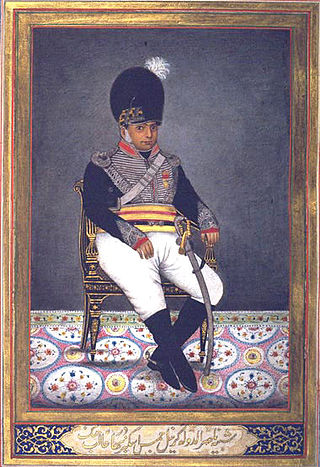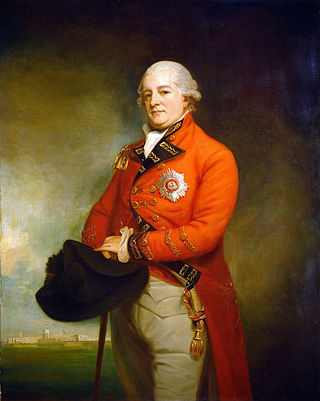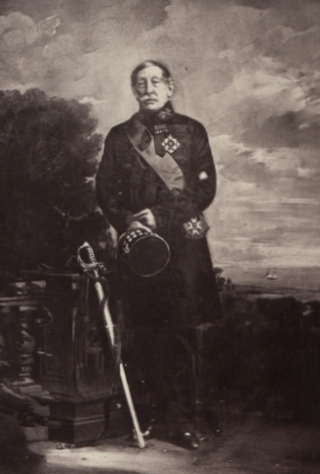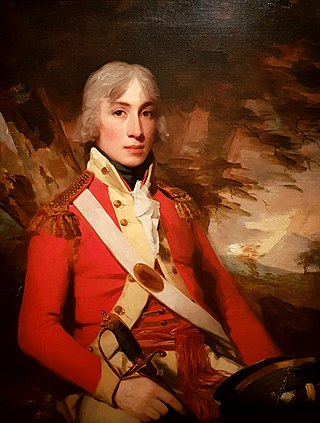Alexander Champion | |
|---|---|
| Died | 15 March 1793 |
| Allegiance | |
| Service/ | British Army |
| Rank | Brigadier General |
| Commands held | Indian Army |
| Battles/wars | Rohilla War |
Brigadier-General Alexander Champion (died 15 March 1793) was Commander-in-Chief, India.
Alexander Champion | |
|---|---|
| Died | 15 March 1793 |
| Allegiance | |
| Service/ | British Army |
| Rank | Brigadier General |
| Commands held | Indian Army |
| Battles/wars | Rohilla War |
Brigadier-General Alexander Champion (died 15 March 1793) was Commander-in-Chief, India.
Champion was commissioned into service for the British East India Company in 1768. [1] He rose through the ranks and was appointed Commander-in-Chief, India in January 1774. [2] On 23 April 1774 Champion defeated the Rohillas (Afghan Highlanders) at Miranpur Katra, killing their leader, Hafiz Rahmat Khan, and ending the Rohilla War. [3]
Champion remained in office until November 1774. [2] He retired to Hatchlands Park near Guildford [4] and died at Bath on 15 March 1793: there is a monument to him in Bath Abbey by Nollekens, which says, 'he rose, in the course of twenty years' active service in India, to the chief command of the company's troops in Bengal.' [5]

On 11 February 1759 Champion married Miss Francis Nynd. [6] Whilst in India he lived with Johanna Barr of Calcutta and left her a house and goods in trust for her natural children Ganny Cummings and Alexander Champion. [7]

Lieutenant-General Sir Eyre Coote, KB was a British soldier and politician who sat in the House of Commons from 1768 to 1780. He is best known for his many years of service with the British Army in India. His victory at the Battle of Wandiwash is considered a decisive turning point in the struggle for control in India between Britain and France. He was known by his sepoy troops as Coote Bahadur.

General Sir Hector Munro, 8th Laird of Novar, KB was a Scottish army officer and politician who served as the ninth Commander-in-Chief of Bengal from 1764 to 1765.

Admiral Sir Richard Hussey Bickerton, 2nd Baronet, KCB, was a British naval officer. He was born in Southampton, the son of Vice-admiral Sir Richard Bickerton and first served aboard HMS Medway in June 1774, in the Mediterranean. His first command came in March 1779 when he was given HM Sloop Swallow as a reward for his part in an engagement with a much larger opponent. Bickerton later joined Rodney's squadron in the West Indies where he took part in the capture of Sint Eustatius in 1781. Making post captain on 8 February 1781, he took temporary command of HMS Invincible and fought in her at the Battle of Fort Royal on 29 April 1781.

Field Marshal Stapleton Cotton, 1st Viscount Combermere, was a British Army officer, diplomat and politician. As a junior officer, he took part in the Flanders Campaign, in the Fourth Anglo-Mysore War and in the suppression of Robert Emmet's insurrection in 1803. He commanded a cavalry brigade in Sir Arthur Wellesley's Army before being given overall command of the cavalry in the latter stages of the Peninsular War. He went on to be Commander-in-Chief, Ireland and then Commander-in-Chief, India. In the latter role he stormed Bharatpur—a fort which previously had been deemed impregnable.

Colonel James Skinner was an Anglo-Indian military adventurer and soldier of the Maratha Empire and the Bengal Army of British India. He became known as Sikandar Sahib later in life and is most known for two cavalry regiments he raised for the British at Hansi in 1803, known as 1st Skinner's Horse and 3rd Skinner's Horse, which are still units of the Indian Army.

Sir Archibald Campbell KB served as governor of Georgia, Jamaica, and Madras. He was a major Scottish landowner, Heritable Usher of the White Rod for Scotland and politician who sat in the House of Commons between 1774 and 1791.

Clan Rattray is a Highland Scottish clan.

Sir Edward Ryan PC FRS was an English lawyer, judge, reformer of the British Civil Service and patron of science. He served as Chief Justice of Bengal from 1833–43.

The First Rohilla War of 1773–1774 was a punitive campaign by Shuja-ud-Daula, Nawab of Awadh on the behalf of Mughal Emperor, against the Rohillas, Indian descendants of Afghan highlanders settled in Rohilkhand, northern India. The Nawab was supported by troops of the British East India Company, in a successful campaign brought about by the Rohillas reneging on a debt to the Nawab.

Field Marshal Sir Alexander George Woodford, GCB, KCMG, was a British Army officer. After taking part in the Anglo-Russian invasion of Holland, he served in most of the battles of the Napoleonic Wars. During the Hundred Days he commanded the 2nd battalion of the Coldstream Guards at the Battle of Quatre Bras, the Battle of Waterloo and the storming of Cambrai. He went on to become lieutenant governor and brigade commander at Malta, lieutenant governor and brigade commander at Corfu and then commander of the British garrison on the Ionian Islands before being appointed Governor and Commander-in-Chief of Gibraltar.
Colonel Hugh Fraser, CB was a British military officer and administrator in India and Burma.
Lieutenant general Sir Charles Edward Nairne was a British military officer who served in British India.
Colonel Charles Chapman was Commander-in-Chief, India.
Brigadier-General Sir Robert Barker, 1st Baronet, FRS was a British Army officer who served in the Seven Years' War and politician who sat in the House of Commons from 1774 to 1780. He served as Commander-in-Chief, India between 1770 and 1773.
Sir Mark Wood, 1st Baronet was a British army officer and engineer. He was a Member of Parliament (MP) for Milborne Port, Gatton and Newark. He received a baronetcy on 3 October 1808.

St. John's Church, originally a cathedral, was among the first public buildings erected by the East India Company after Kolkata (Calcutta) became the effective capital of British India. It is located at the North-Western corner of Raj Bhavan, and served as the Anglican Cathedral of Calcutta till 1847, when the see was transferred to St. Paul's Cathedral. Construction of the building, modelled on St Martin-in-the-Fields of London, started in 1784, with Rs 30,000 raised through a public lottery, and was completed in 1787. The land the church stands on was gifted by Maharaja Nabo Kishen Bahadur of Sobhabazar. It is the third oldest church in the city, next to the Armenian Church of the Holy Nazareth and the Old Mission Church.

William Kirkpatrick (1754–1812) was an East India Company officer, diplomat and orientalist active in Colonial India during the period of Company rule.

The Kingdom of Rohilkhand was a late modern Indian kingdom under nominal Mughal suzerainty, that rose under the declining Mughal Empire in 1721 and continued to exist until 1774 when it was defeated by Oudh the British transformed its significantly reduced borders into the princely state of Rampur. Nawab Ali Mohammed Khan became the first Nawab of Rohilkhand, having been previously elected as overlord by various Afghan chiefs at the age of fourteen. He would carve out the future kingdom from the collapsing Mughal Empire and go on to the found the Rohilla dynasty. The crown would go on being held by the Rohillas until the kingdom came to an end in 1774, and thereafter the same dynasty would rule over Rampur.
Lieutenant-Colonel Sir John Macgregor Murray, 1st Baronet, born John Murray, was a Scottish army officer.

Major-General Alexander Murray Macgregor, born Alexander Murray, was a Scottish army officer in the British East India Company.